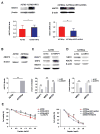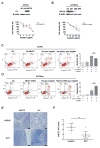ABCF2, an Nrf2 target gene, contributes to cisplatin resistance in ovarian cancer cells
- PMID: 28112439
- PMCID: PMC5509336
- DOI: 10.1002/mc.22615
ABCF2, an Nrf2 target gene, contributes to cisplatin resistance in ovarian cancer cells
Abstract
Previously, we have demonstrated that NRF2 plays a key role in mediating cisplatin resistance in ovarian cancer. To further explore the mechanism underlying NRF2-dependent cisplatin resistance, we stably overexpressed or knocked down NRF2 in parental and cisplatin-resistant human ovarian cancer cells, respectively. These two pairs of stable cell lines were then subjected to microarray analysis, where we identified 18 putative NRF2 target genes. Among these genes, ABCF2, a cytosolic member of the ABC superfamily of transporters, has previously been reported to contribute to chemoresistance in clear cell ovarian cancer. A detailed analysis on ABCF2 revealed a functional antioxidant response element (ARE) in its promoter region, establishing ABCF2 as an NRF2 target gene. Next, we investigated the contribution of ABCF2 in NRF2-mediated cisplatin resistance using our stable ovarian cancer cell lines. The NRF2-overexpressing cell line, containing high levels of ABCF2, was more resistant to cisplatin-induced apoptosis compared to its control cell line; whereas the NRF2 knockdown cell line with low levels of ABCF2, was more sensitive to cisplatin treatment than its control cell line. Furthermore, transient overexpression of ABCF2 in the parental cells decreased apoptosis and increased cell viability following cisplatin treatment. Conversely, knockdown of ABCF2 using specific siRNA notably increased apoptosis and decreased cell viability in cisplatin-resistant cells treated with cisplatin. This data indicate that the novel NRF2 target gene, ABCF2, plays a critical role in cisplatin resistance in ovarian cancer, and that targeting ABCF2 may be a new strategy to improve chemotherapeutic efficiency.
Keywords: ABCF2; NRF2; chemoresistance; cisplatin; ovarian cancer.
© 2017 Wiley Periodicals, Inc.
Conflict of interest statement
Figures






Similar articles
-
Nrf2 induced cisplatin resistance in ovarian cancer by promoting CD99 expression.Biochem Biophys Res Commun. 2019 Oct 22;518(4):698-705. doi: 10.1016/j.bbrc.2019.08.113. Epub 2019 Aug 28. Biochem Biophys Res Commun. 2019. PMID: 31472965
-
The Nrf2 transcription factor contributes to resistance to cisplatin in bladder cancer.Urol Oncol. 2014 Aug;32(6):806-14. doi: 10.1016/j.urolonc.2014.02.006. Epub 2014 May 16. Urol Oncol. 2014. PMID: 24837013
-
Hexokinase 2 confers resistance to cisplatin in ovarian cancer cells by enhancing cisplatin-induced autophagy.Int J Biochem Cell Biol. 2018 Feb;95:9-16. doi: 10.1016/j.biocel.2017.12.010. Epub 2017 Dec 13. Int J Biochem Cell Biol. 2018. PMID: 29247711
-
Emerging role of NRF2 in ROS-mediated tumor chemoresistance.Biomed Pharmacother. 2020 Nov;131:110676. doi: 10.1016/j.biopha.2020.110676. Epub 2020 Aug 25. Biomed Pharmacother. 2020. PMID: 32858502 Review.
-
NFR2/ABC transporter axis in drug resistance of breast cancer cells.Mol Biol Rep. 2023 Jun;50(6):5407-5414. doi: 10.1007/s11033-023-08384-7. Epub 2023 Apr 20. Mol Biol Rep. 2023. PMID: 37081307 Review.
Cited by
-
Tumour Microenvironment Stress Promotes the Development of Drug Resistance.Antioxidants (Basel). 2021 Nov 11;10(11):1801. doi: 10.3390/antiox10111801. Antioxidants (Basel). 2021. PMID: 34829672 Free PMC article. Review.
-
Label-Free Quantitative Proteomics Analysis of Adriamycin Selected Multidrug Resistant Human Lung Cancer Cells.Biomolecules. 2022 Oct 1;12(10):1401. doi: 10.3390/biom12101401. Biomolecules. 2022. PMID: 36291610 Free PMC article.
-
MicroRNA-Based Combinatorial Cancer Therapy: Effects of MicroRNAs on the Efficacy of Anti-Cancer Therapies.Cells. 2019 Dec 20;9(1):29. doi: 10.3390/cells9010029. Cells. 2019. PMID: 31861937 Free PMC article. Review.
-
A CRISPR screen identifies redox vulnerabilities for KEAP1/NRF2 mutant non-small cell lung cancer.Redox Biol. 2022 Aug;54:102358. doi: 10.1016/j.redox.2022.102358. Epub 2022 Jun 2. Redox Biol. 2022. PMID: 35667246 Free PMC article.
-
Targeting Nrf2 may reverse the drug resistance in ovarian cancer.Cancer Cell Int. 2021 Feb 17;21(1):116. doi: 10.1186/s12935-021-01822-1. Cancer Cell Int. 2021. PMID: 33596893 Free PMC article. Review.
References
-
- Jayson GC, Kohn EC, Kitchener HC, Ledermann JA. Ovarian cancer. Lancet. 2014;384(9951):1376–1388. - PubMed
-
- Kehoe S, Hook J, Nankivell M, et al. Primary chemotherapy versus primary surgery for newly diagnosed advanced ovarian cancer (CHORUS): an open-label, randomised, controlled, non-inferiority trial. Lancet. 2015;386(9990):249–257. - PubMed
Publication types
MeSH terms
Substances
Grants and funding
LinkOut - more resources
Full Text Sources
Other Literature Sources
Medical
Molecular Biology Databases

